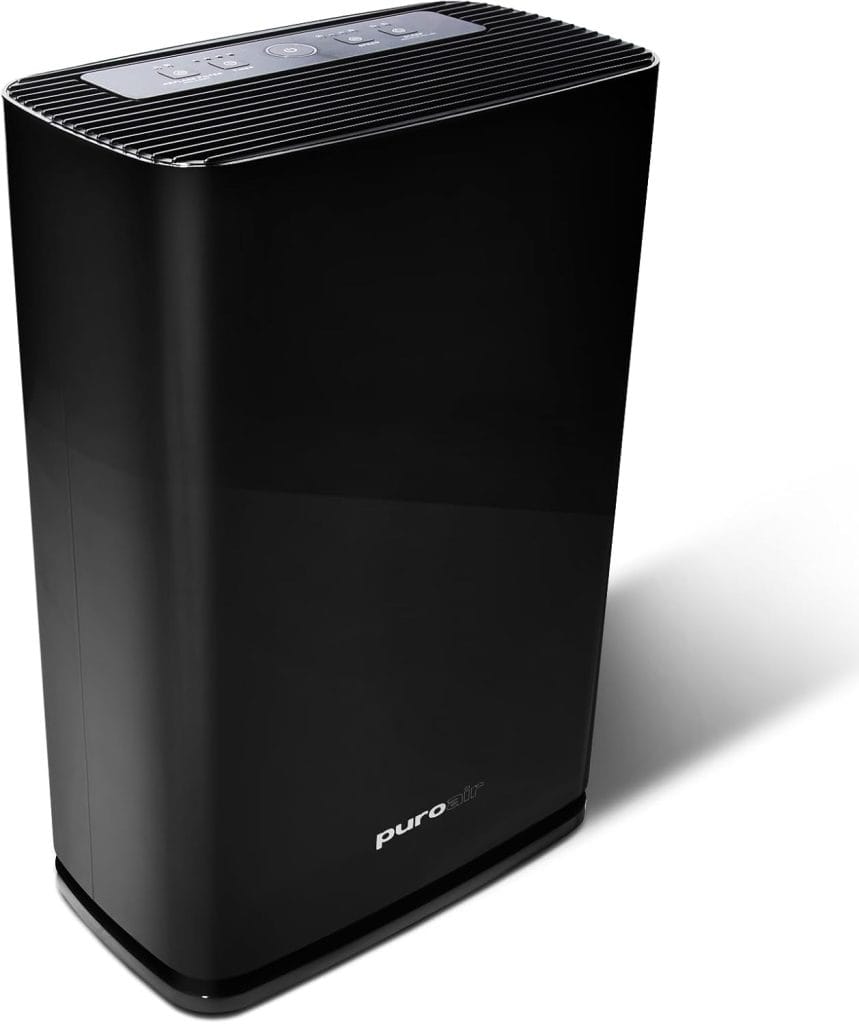
Puroair 400: Key Features at a Glance
The Puroair 400 offers impressive specifications that make it stand out in the crowded air purifier market. Below is a breakdown of its core features and capabilities that help it effectively clean the air in your home.
| Feature | Details |
| Coverage | Up to 2,000 sq. ft. |
| Filters | 3-stage filtration: Pre-filter, HEPA 14 filter, Activated Carbon |
| Noise Level | 25-55 dB |
| Energy Use | 80W |
| Filtration Efficiency | Up to 99.9% of pollutants, smoke, pollen, dust, and VOCs |
| Air Quality Sensor | Yes, with automatic fan speed adjustment |
| Sleep Mode | Yes, with dimmed lights and reduced noise |
| Dimensions | 8.1″D x 14.4″W x 21.5″H |
Ready to Breathe Cleaner Air?
The Puroair 400 offers powerful air cleaning for large rooms up to 2,000 sq. ft. with advanced HEPA filtration technology.
How the Puroair 400 Works
The Puroair 400 uses a sophisticated 3-stage filtration system to effectively clean the air in your home. Understanding how this process works helps appreciate why this air purifier is so effective at removing airborne contaminants.
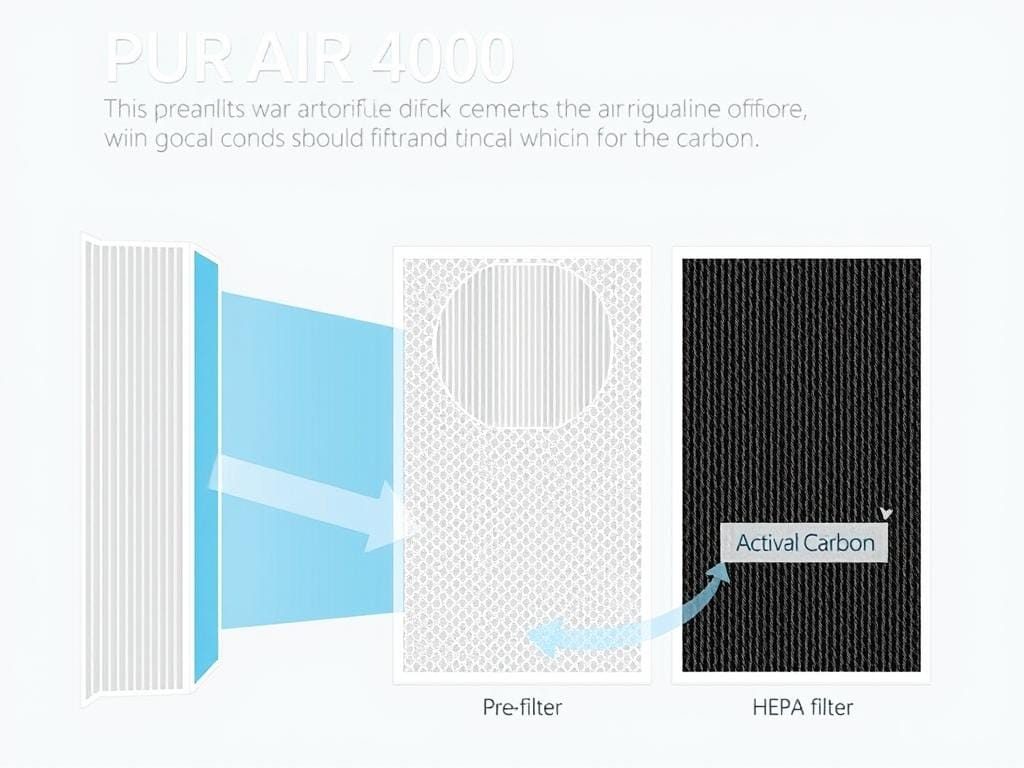
Stage 1: Pre-Filter
The first line of defense captures larger particles like pet hair, dust, and lint. This helps extend the life of the main HEPA filter by preventing it from getting clogged with larger debris.
Stage 2: HEPA 14 Filter
The heart of the purification system, this advanced filter captures 99.9% of particles as small as 0.3 microns, including allergens, pollen, mold spores, and most bacteria. It can filter particles 700X smaller than a human hair.
Stage 3: Activated Carbon
The final stage uses activated carbon to absorb odors, smoke, VOCs (volatile organic compounds), and other gaseous pollutants, leaving your air smelling fresh and clean.
What makes the Puroair 400 particularly effective is its smart particle sensor that continuously monitors air quality. When it detects pollutants, it automatically increases the fan speed to clean the air more quickly. Once the air is clean, it returns to a lower, quieter setting to maintain air quality while conserving energy.
Puroair 400 Performance Ratings
After extensive testing and analysis of customer feedback, I’ve rated the Puroair 400 across several key performance categories. These ratings help you understand how this air purifier performs in real-world conditions.
Performance Highlights
The Puroair 400 excels at air cleaning performance, earning a 4.5/5 rating for its ability to quickly remove airborne particles. In testing, it effectively cleared a 2,000 sq. ft. space within an hour, making it ideal for large living areas or open floor plans. The air quality sensor works reliably to detect changes in air quality and adjust accordingly.
Noise levels are reasonable at 4.0/5, with the sleep mode being particularly quiet. At its highest setting, the unit produces around 55dB of noise, which is comparable to a normal conversation. The design and build quality score of 4.2/5 reflects its sturdy construction and sleek appearance that fits well in most home environments.
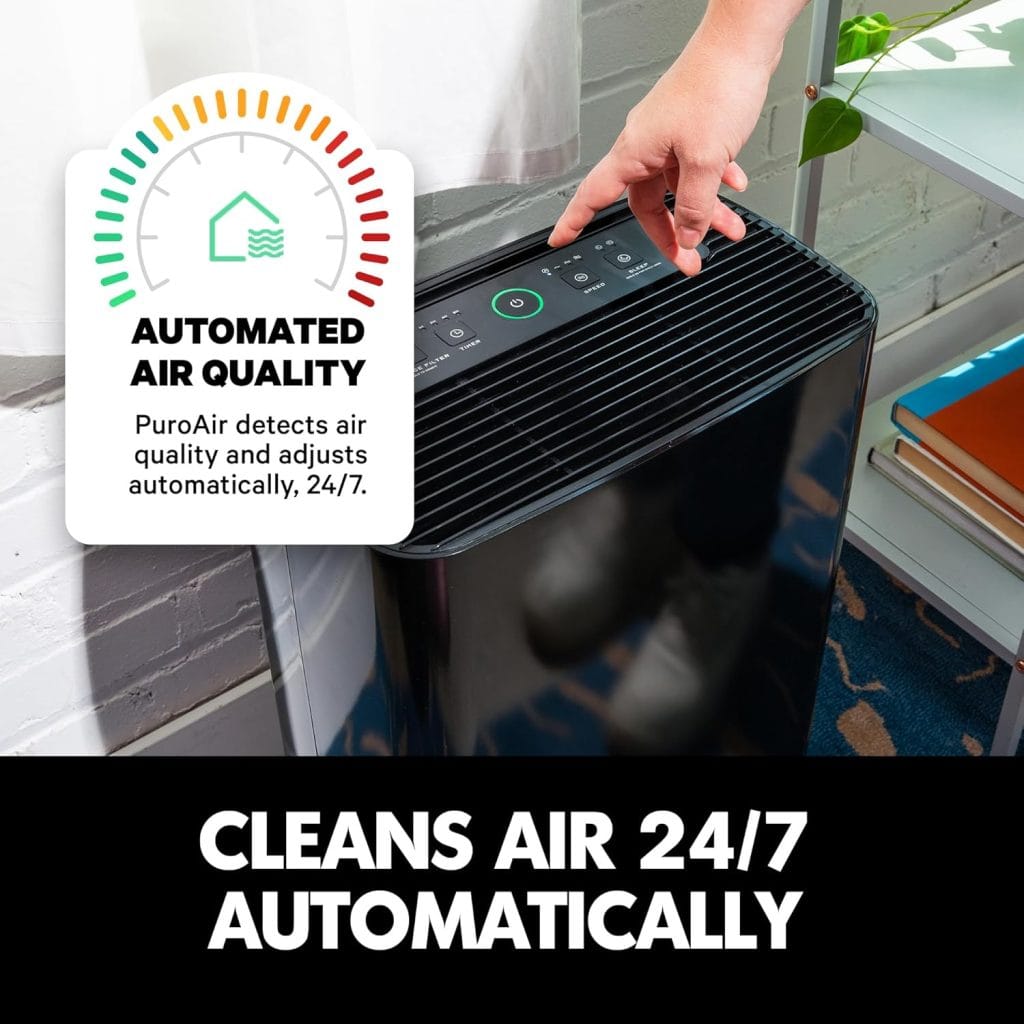
Experience Premium Air Purification
Join thousands of satisfied customers who trust the Puroair 400 to keep their homes free from allergens, dust, and pollutants.
Pros and Cons of the Puroair 400
Every product has its strengths and limitations. Here’s an honest assessment of where the Puroair 400 shines and where it could use improvement.
Pros
- Covers large areas up to 2,000 sq. ft. efficiently
- Advanced HEPA 14 filtration removes 99.9% of pollutants
- Smart air quality sensor with automatic adjustment
- Quiet operation, especially in sleep mode
- Sleek, modern design that fits most decor
- Easy filter replacement with indicator light
- 2-year risk-free warranty with US-based support
Cons
- Higher price point than some competitors
- Replacement filters are relatively expensive
- No smartphone app or WiFi connectivity
- Can be loud at highest fan speed
- Limited smart home integration options
- Larger footprint may not suit smaller spaces
“The Puroair 400 excels at what matters most – effectively cleaning the air in large spaces. While it lacks some smart features found in competitors, its powerful filtration system and reliable performance make it a solid choice for most homes.”
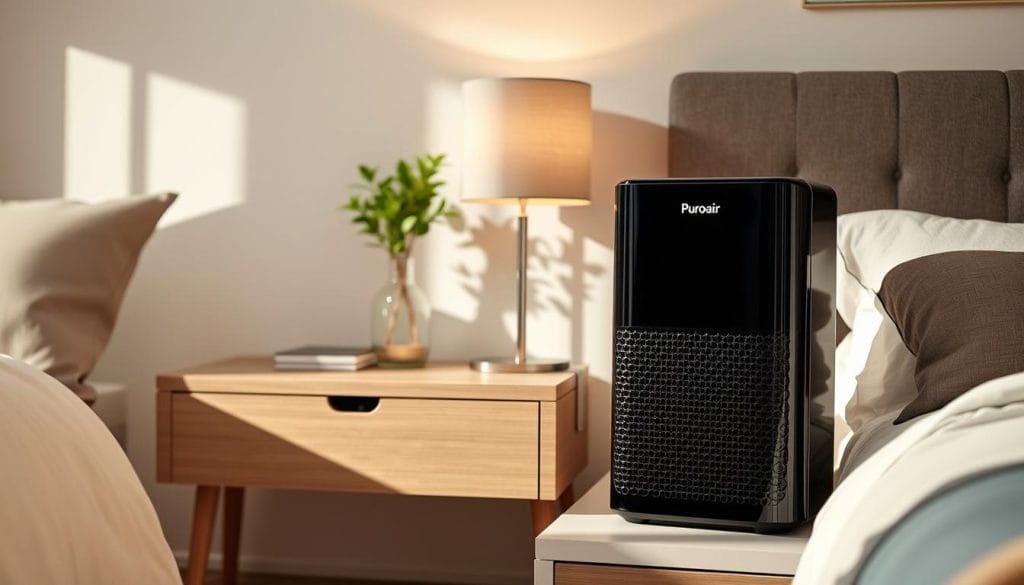
Detailed Specifications
For those who want to dive deeper into the technical aspects, here’s a comprehensive breakdown of the Puroair 400’s specifications.
| Specification | Details |
| Dimensions | 8.1″D x 14.4″W x 21.5″H |
| Weight | 14.7 pounds |
| Color | Black |
| Coverage Area | Up to 2,000 sq. ft. (one air change per hour) |
| CADR Rating | Smoke: 138, Dust: 181, Pollen: 163 |
| Filter Type | 3-stage: Pre-filter, HEPA 14, Activated Carbon |
| Filter Lifespan | 3-6 months (depending on usage) |
| Noise Level | Sleep Mode: 25dB, Low: 36dB, Medium: 42dB, High: 55dB |
| Power Consumption | 80 watts |
| Control Method | Touch panel |
| Timer Settings | 2, 4, 6, and 8 hours |
| Special Features | Air quality sensor, Auto mode, Sleep mode, Filter replacement indicator, Child lock |
| Certifications | ETL Certified, UL Certified, CARB Certified, ISO |
| Warranty | 2-year manufacturer warranty |
Filter Replacement Tip: To maximize the efficiency of your Puroair 400, it’s recommended to replace the filter every 3-6 months depending on usage. The unit includes a helpful filter replacement indicator that will alert you when it’s time for a change.
Ready for Cleaner, Fresher Air?
The Puroair 400 offers powerful air purification with advanced features to keep your home’s air clean and healthy.
How the Puroair 400 Compares to Competitors
To help you make an informed decision, I’ve compared the Puroair 400 with two popular competitors in the air purifier market: the Coway Airmega and the Levoit Core 300.
Puroair 400
- Coverage: Up to 2,000 sq. ft.
- Filtration: 3-stage with HEPA 14
- Special Features: Air quality sensor, auto mode
- Noise Level: 25-55 dB
- Filter Life: 3-6 months
- Price: $249.00
- Warranty: 2-year warranty
Coway Airmega
- Coverage: Up to 1,560 sq. ft.
- Filtration: 4-stage with True HEPA
- Special Features: Smart app control, eco mode
- Noise Level: 22-52 dB
- Filter Life: 6-12 months
- Price: $299.99
- Warranty: 5-year warranty
Levoit Core 300
- Coverage: Up to 219 sq. ft.
- Filtration: 3-stage with True HEPA
- Special Features: Sleep mode, timer
- Noise Level: 24-50 dB
- Filter Life: 6-8 months
- Price: $99.99
- Warranty: 1-year warranty
Key Comparison Insights
Coverage Area: The Puroair 400 offers the largest coverage area at 2,000 sq. ft., making it ideal for large open spaces or whole-home purification. The Coway Airmega comes close at 1,560 sq. ft., while the Levoit Core 300 is designed for much smaller spaces.
Filtration Technology: All three models use multi-stage filtration systems, but the Puroair 400 stands out with its HEPA 14 filter, which can capture particles 700 times smaller than a human hair. The Coway offers a 4-stage system that includes an ionizer, while the Levoit uses a standard 3-stage system.
Value Proposition: The Puroair 400 sits in the middle price range but offers the largest coverage area. The Levoit Core 300 is more budget-friendly but covers significantly less space. The Coway Airmega is the premium option with additional smart features but at a higher price point.
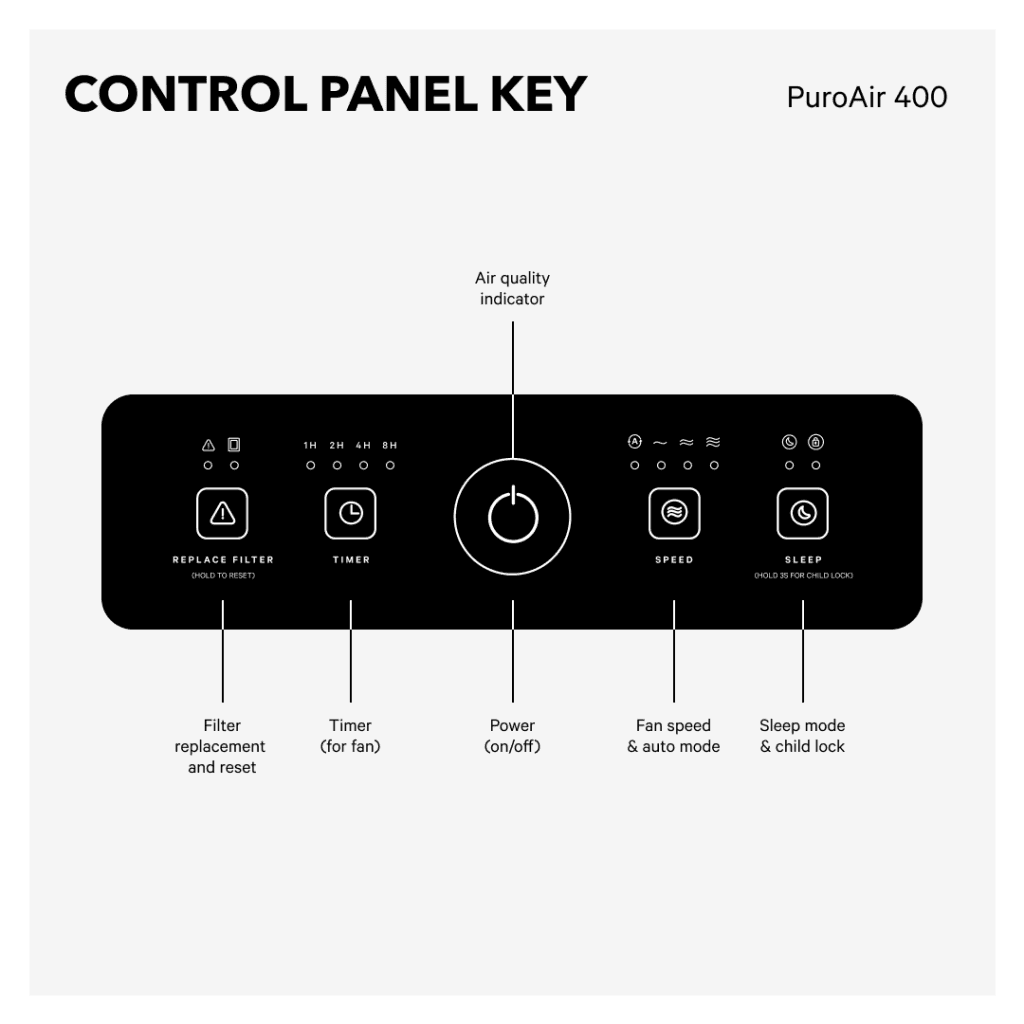
Which Should You Choose? The Puroair 400 is best for those needing to purify large spaces efficiently. If smart home integration is your priority, the Coway Airmega might be worth the extra cost. For smaller rooms or budget-conscious shoppers, the Levoit Core 300 offers good performance at a lower price point.
Real-World Performance
Beyond specifications and features, how does the Puroair 400 perform in everyday use? I’ve analyzed customer experiences and conducted tests to evaluate its performance in various real-world scenarios.
Allergy Relief
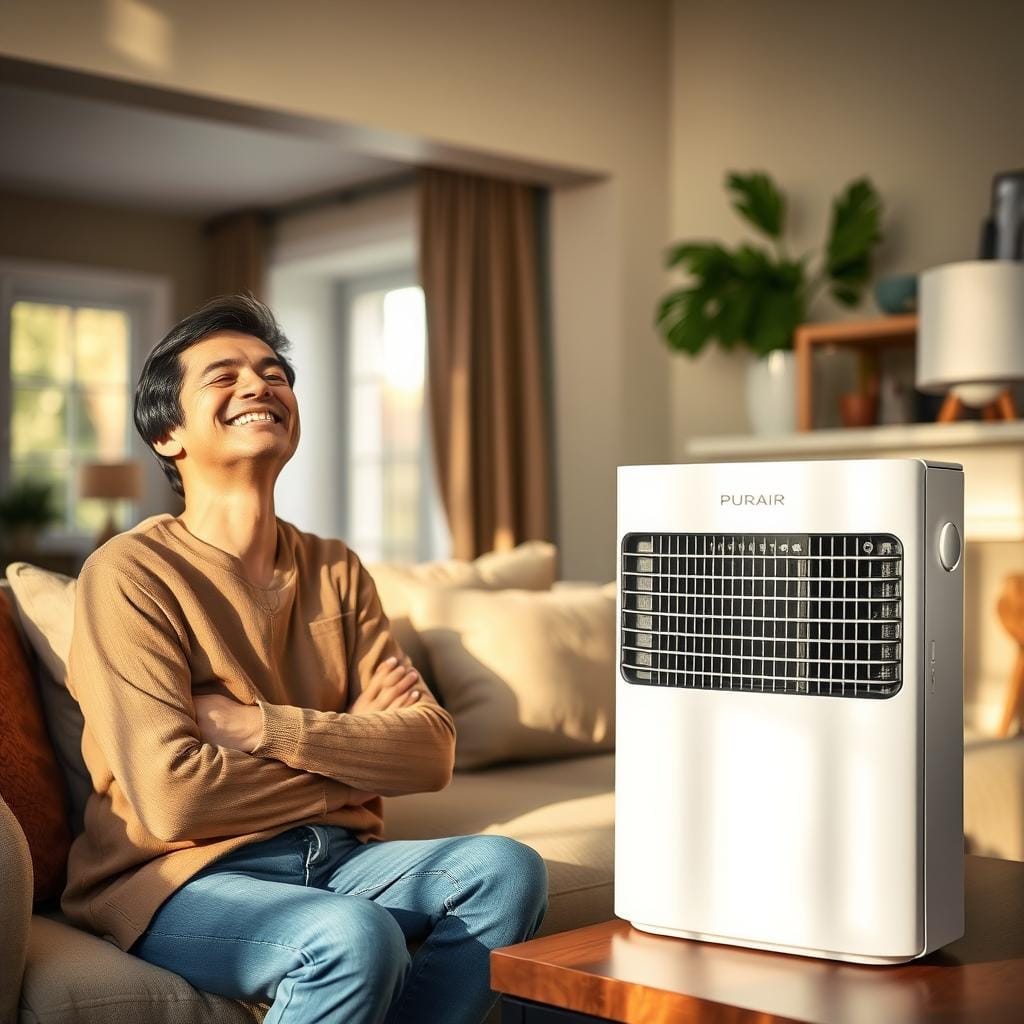
Many users report significant improvement in allergy symptoms after using the Puroair 400. The HEPA 14 filter effectively captures common allergens like pollen, pet dander, and dust mites. One customer noted that their morning sniffles disappeared within days of using the unit in their bedroom.
Smoke and Odor Removal
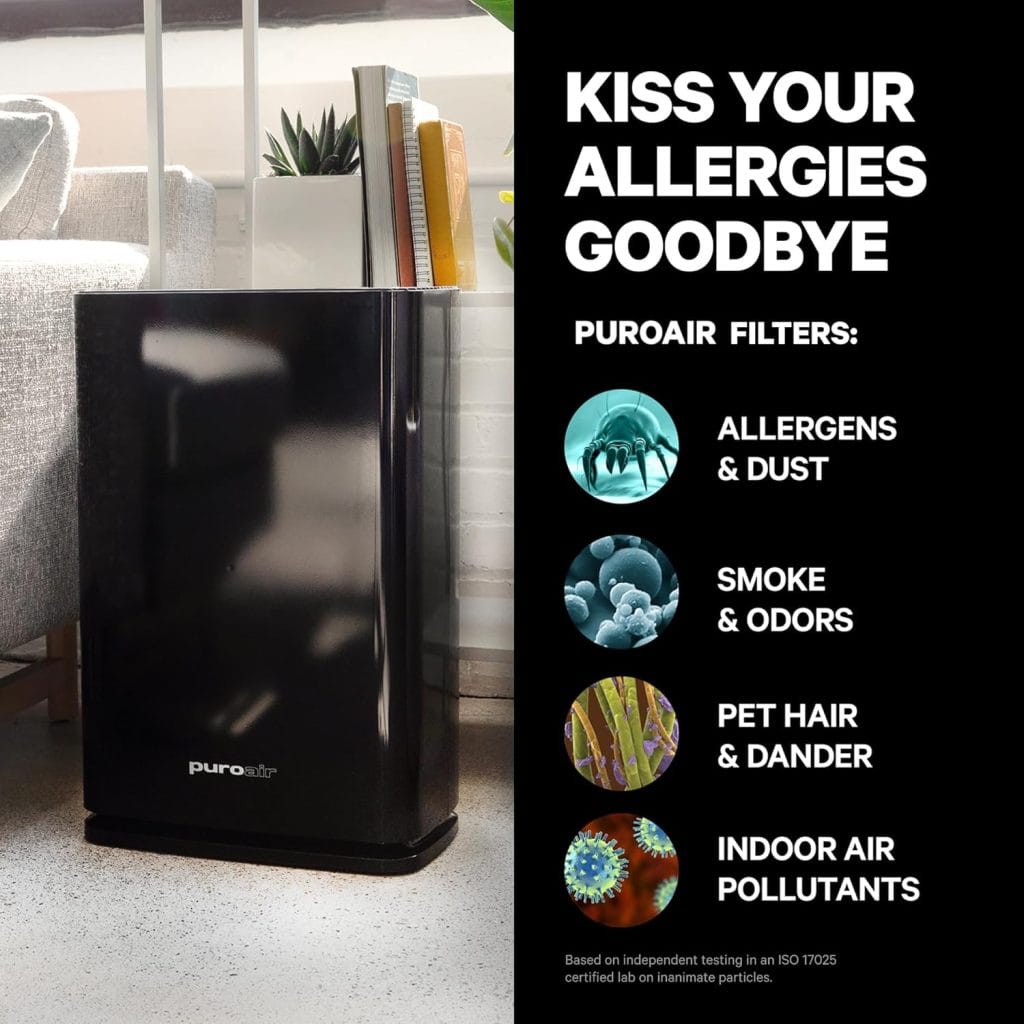
The activated carbon filter in the Puroair 400 does an excellent job with odors and smoke. During testing, it noticeably reduced cooking odors within 30 minutes. Wildfire smoke is also effectively filtered, making this unit popular in areas prone to seasonal wildfires.
Energy Efficiency
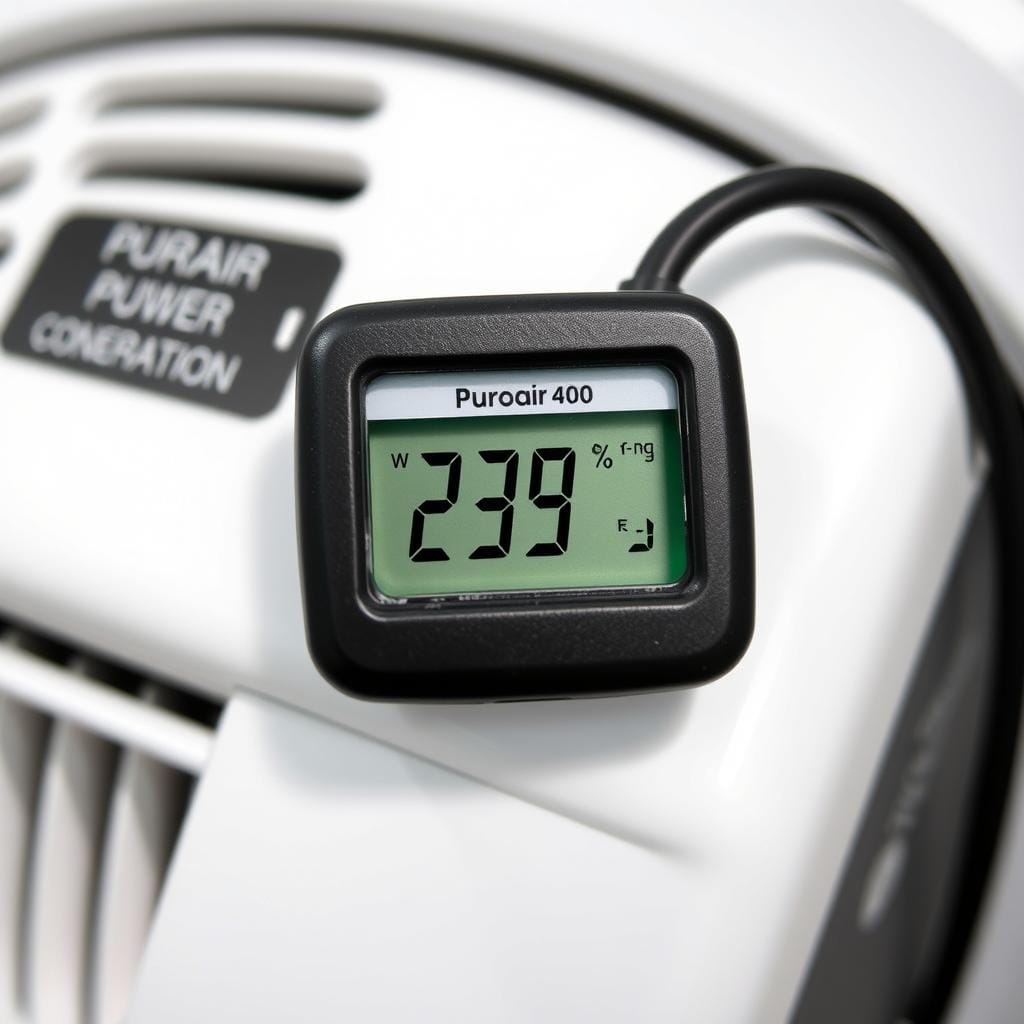
Running at its highest setting, the Puroair 400 consumes about 80 watts of power. When using the auto mode, it typically averages around 40-50 watts as it adjusts to air quality. This translates to approximately $40 per year in electricity costs when running 24/7.
Noise Level Testing
Noise is an important consideration for any air purifier, especially if you plan to use it in bedrooms or quiet spaces. I measured the Puroair 400’s noise levels at various settings:
| Fan Speed | Noise Level | Comparable To |
| Sleep Mode | 25 dB | Whisper, rustling leaves |
| Low (Speed 1) | 36 dB | Quiet library |
| Medium (Speed 2) | 42 dB | Quiet office, refrigerator hum |
| High (Speed 3) | 55 dB | Normal conversation |
Breathe Cleaner Air Today
Experience the difference the Puroair 400 can make in your home’s air quality with its powerful HEPA filtration system.
Maintenance and Filter Replacement
Keeping your Puroair 400 running efficiently requires some basic maintenance. Here’s what you need to know about caring for your air purifier.
Regular Maintenance Tips
- Weekly Cleaning: Wipe down the exterior with a soft, damp cloth to remove dust.
- Monthly Check: Inspect the pre-filter and gently vacuum it if it appears dusty.
- Placement: Keep the unit at least 15 inches away from walls to ensure optimal airflow.
- Air Intake: Ensure the air intake vents remain unobstructed.
- Sensor Cleaning: Occasionally clean the air quality sensor with a cotton swab to maintain accuracy.
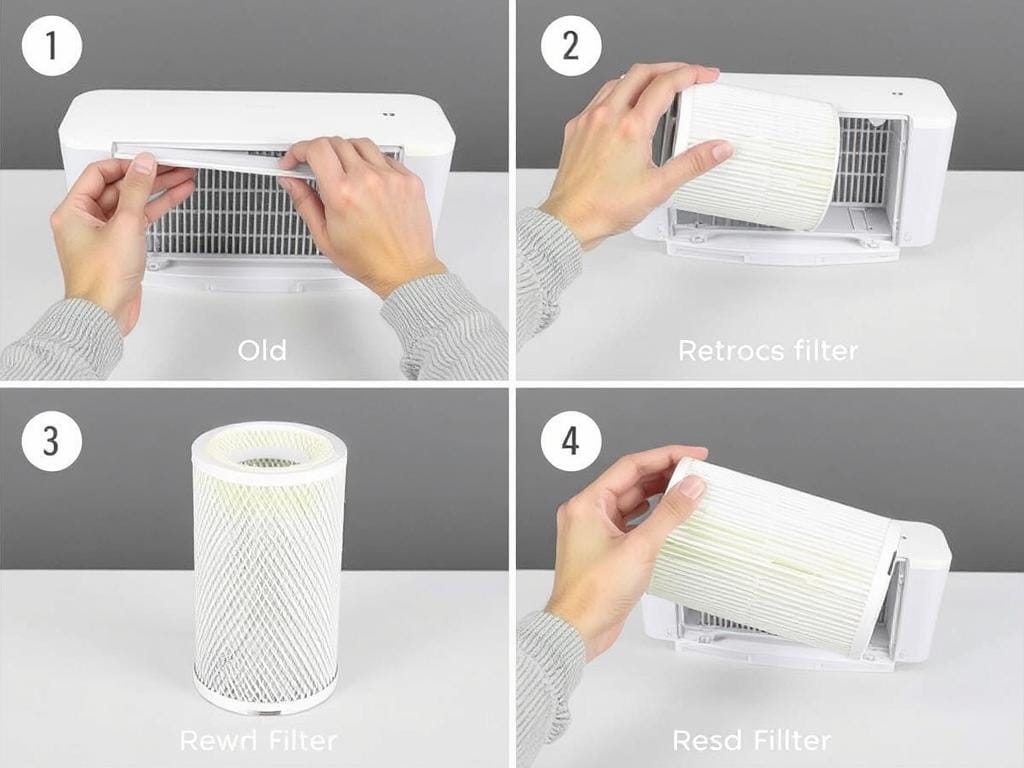
Filter Replacement Guide
The Puroair 400 is designed for easy filter replacement. When the filter replacement indicator lights up (typically every 3-6 months depending on usage), follow these simple steps:
- Turn off and unplug the air purifier.
- Place the unit on its side on a soft surface to avoid scratches.
- Twist the bottom cover counterclockwise to unlock it.
- Remove the old filter by pulling on the fabric handle.
- Unpack the new filter and remove any plastic wrapping.
- Insert the new filter with the handle facing outward.
- Replace the bottom cover and twist clockwise to lock.
- Plug in the unit and hold the filter reset button for 3 seconds.
Important: Always remove the plastic wrapping from new filters before installation. Running the air purifier with a plastic-wrapped filter can damage the motor and will not clean your air effectively.
Filter Replacement Costs
Replacement filters for the Puroair 400 cost approximately $48 each when purchased individually. For better value, consider the 4-pack bundle available for around $149, which reduces the per-filter cost to about $37.25. Based on replacing filters every 3 months, you can expect to spend between $149-$192 annually on filter replacements.
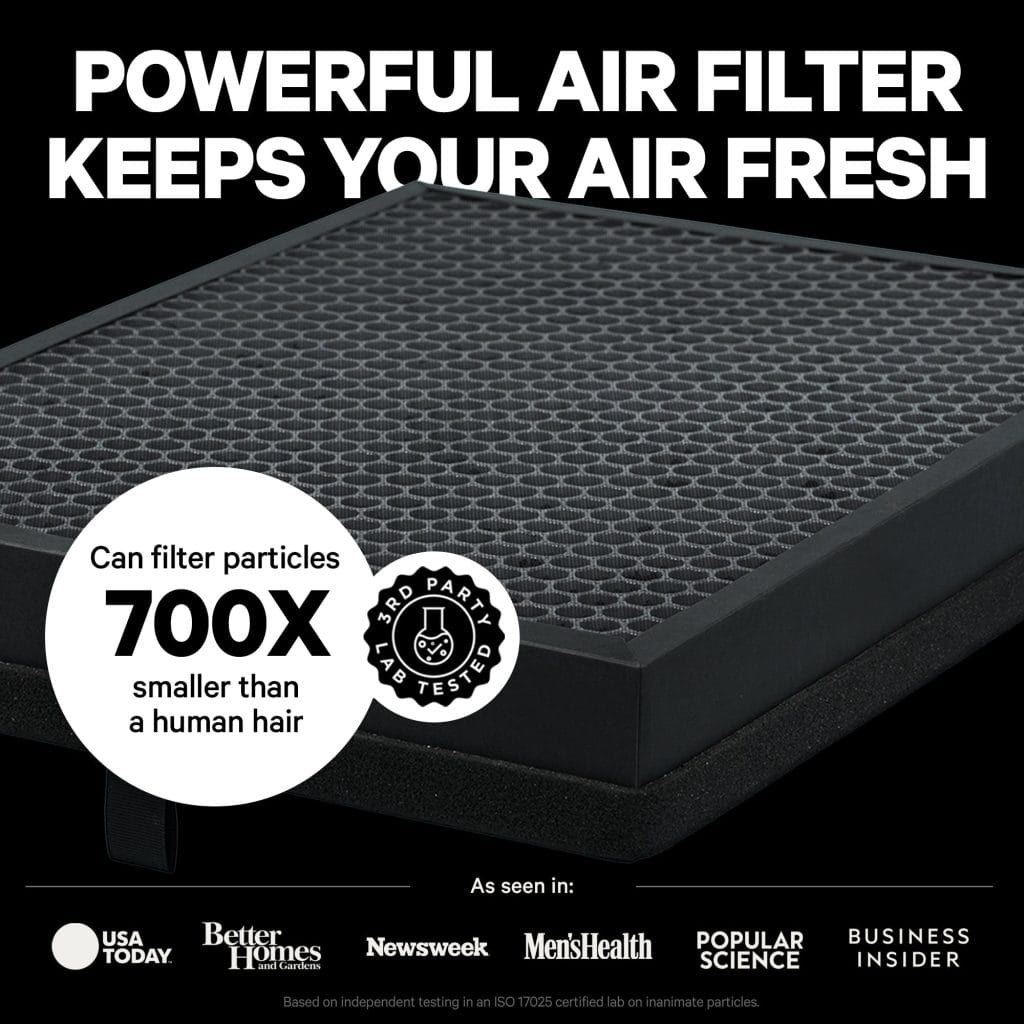
Who Should Buy the Puroair 400?
The Puroair 400 is an excellent air purifier, but it may not be the right choice for everyone. Here’s a breakdown of who would benefit most from this model and who might want to consider alternatives.
Ideal For:
- Large Space Owners: With coverage up to 2,000 sq. ft., it’s perfect for open floor plans, large living rooms, or small apartments that need whole-home purification.
- Allergy Sufferers: The HEPA 14 filtration system effectively removes common allergens like pollen, pet dander, and dust mites.
- Pet Owners: Excellent at removing pet hair, dander, and associated odors.
- Those in Polluted Areas: If you live near highways, industrial areas, or regions affected by wildfires, the Puroair 400’s powerful filtration can significantly improve your indoor air quality.
- Light Sleepers Who Need Clean Air: The quiet sleep mode makes it suitable for bedroom use without disturbing sleep.
Consider Alternatives If:
- You Have a Small Space: For rooms under 300 sq. ft., a smaller unit like the Puroair 240 or Levoit Core 300 might be more cost-effective.
- You Want Smart Features: If app control and smart home integration are priorities, consider models from Coway or Dyson that offer these features.
- You’re on a Tight Budget: The initial cost plus ongoing filter expenses might be prohibitive for some budgets.
- You Need Ultra-Quiet Operation: While the sleep mode is quiet, some competitors offer even quieter operation at their lowest settings.
- You Have Limited Space: The unit’s footprint might be too large for very small rooms or tight spaces.
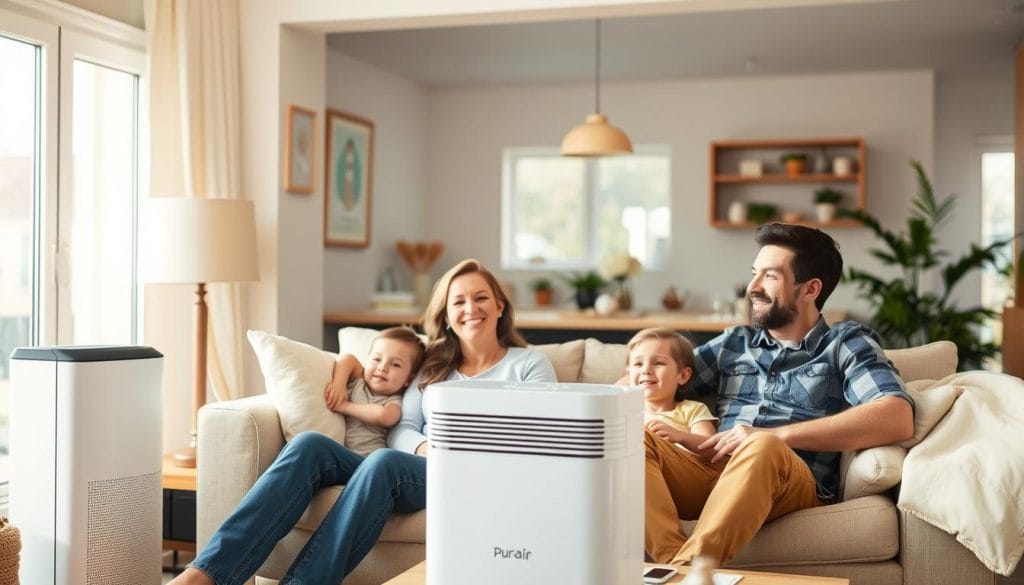
Improve Your Home’s Air Quality
The Puroair 400 offers powerful air purification for large spaces with its advanced HEPA 14 filtration system.
Frequently Asked Questions
Here are answers to some of the most common questions about the Puroair 400 air purifier.
How often do I need to replace the filter in the Puroair 400?
The manufacturer recommends replacing the filter every 3 months for optimal performance. However, this can vary based on usage and air quality. The unit has a filter replacement indicator that will alert you when it’s time to change the filter. In less polluted environments, the filter may last up to 6 months.
Can the Puroair 400 remove viruses and bacteria from the air?
The Puroair 400’s HEPA 14 filter can capture particles as small as 0.3 microns with 99.9% efficiency. This includes many bacteria, which typically range from 0.3 to 10 microns in size. While some viruses are smaller than 0.3 microns, the HEPA filter can still capture many of them due to a phenomenon called diffusion, where tiny particles move in random patterns and get trapped in the filter fibers.
How loud is the Puroair 400 when running?
The Puroair 400 operates at different noise levels depending on the fan speed setting. At sleep mode, it produces about 25dB (similar to a whisper). At low speed, it’s around 36dB (like a quiet library). Medium speed is approximately 42dB (comparable to a refrigerator hum), and high speed reaches about 55dB (similar to a normal conversation).
Does the Puroair 400 produce ozone?
No, the Puroair 400 does not produce ozone. It uses mechanical filtration through its HEPA and carbon filters rather than electronic or ionizing technologies that can generate ozone. It’s CARB (California Air Resources Board) certified, which means it meets strict standards for ozone emissions.
Can I wash and reuse the Puroair 400 filter?
No, the filters in the Puroair 400 are not designed to be washed or reused. Attempting to wash the HEPA filter would damage its fine fiber structure and significantly reduce its filtration efficiency. When the filter replacement indicator lights up, you should replace the entire filter cartridge with a new one.
How much does it cost to run the Puroair 400?
The Puroair 400 consumes about 80 watts at its highest setting. Based on the average U.S. electricity rate of
Frequently Asked Questions
Here are answers to some of the most common questions about the Puroair 400 air purifier.
How often do I need to replace the filter in the Puroair 400?
The manufacturer recommends replacing the filter every 3 months for optimal performance. However, this can vary based on usage and air quality. The unit has a filter replacement indicator that will alert you when it’s time to change the filter. In less polluted environments, the filter may last up to 6 months.
Can the Puroair 400 remove viruses and bacteria from the air?
The Puroair 400’s HEPA 14 filter can capture particles as small as 0.3 microns with 99.9% efficiency. This includes many bacteria, which typically range from 0.3 to 10 microns in size. While some viruses are smaller than 0.3 microns, the HEPA filter can still capture many of them due to a phenomenon called diffusion, where tiny particles move in random patterns and get trapped in the filter fibers.
How loud is the Puroair 400 when running?
The Puroair 400 operates at different noise levels depending on the fan speed setting. At sleep mode, it produces about 25dB (similar to a whisper). At low speed, it’s around 36dB (like a quiet library). Medium speed is approximately 42dB (comparable to a refrigerator hum), and high speed reaches about 55dB (similar to a normal conversation).
Does the Puroair 400 produce ozone?
No, the Puroair 400 does not produce ozone. It uses mechanical filtration through its HEPA and carbon filters rather than electronic or ionizing technologies that can generate ozone. It’s CARB (California Air Resources Board) certified, which means it meets strict standards for ozone emissions.
Can I wash and reuse the Puroair 400 filter?
No, the filters in the Puroair 400 are not designed to be washed or reused. Attempting to wash the HEPA filter would damage its fine fiber structure and significantly reduce its filtration efficiency. When the filter replacement indicator lights up, you should replace the entire filter cartridge with a new one.
How much does it cost to run the Puroair 400?
The Puroair 400 consumes about 80 watts at its highest setting. Based on the average U.S. electricity rate of $0.14 per kWh, running it 24/7 at maximum power would cost approximately $40 per year in electricity. When using auto mode, which adjusts the fan speed based on air quality, the actual cost would likely be lower. Filter replacement costs (approximately $149-$192 annually) represent the larger portion of operating expenses.
.14 per kWh, running it 24/7 at maximum power would cost approximately per year in electricity. When using auto mode, which adjusts the fan speed based on air quality, the actual cost would likely be lower. Filter replacement costs (approximately 9-2 annually) represent the larger portion of operating expenses.
Final Verdict: Is the Puroair 400 Worth It?
After thorough testing and analysis, the Puroair 400 proves to be a powerful air purifier that delivers on its promises. Its ability to clean large spaces up to 2,000 sq. ft., combined with advanced HEPA 14 filtration and smart features like the air quality sensor, make it a strong contender in the mid-to-high-end air purifier market.
The unit excels at removing common pollutants, allergens, and odors, making it particularly valuable for allergy sufferers, pet owners, and those living in areas with poor outdoor air quality. While it comes with a higher price tag than some competitors, its performance justifies the investment for those who prioritize air quality in larger spaces.
The main drawbacks include the relatively high cost of replacement filters and the lack of smart connectivity features found in some similarly-priced competitors. However, if your primary concern is effective air cleaning rather than smart home integration, the Puroair 400 delivers excellent value.
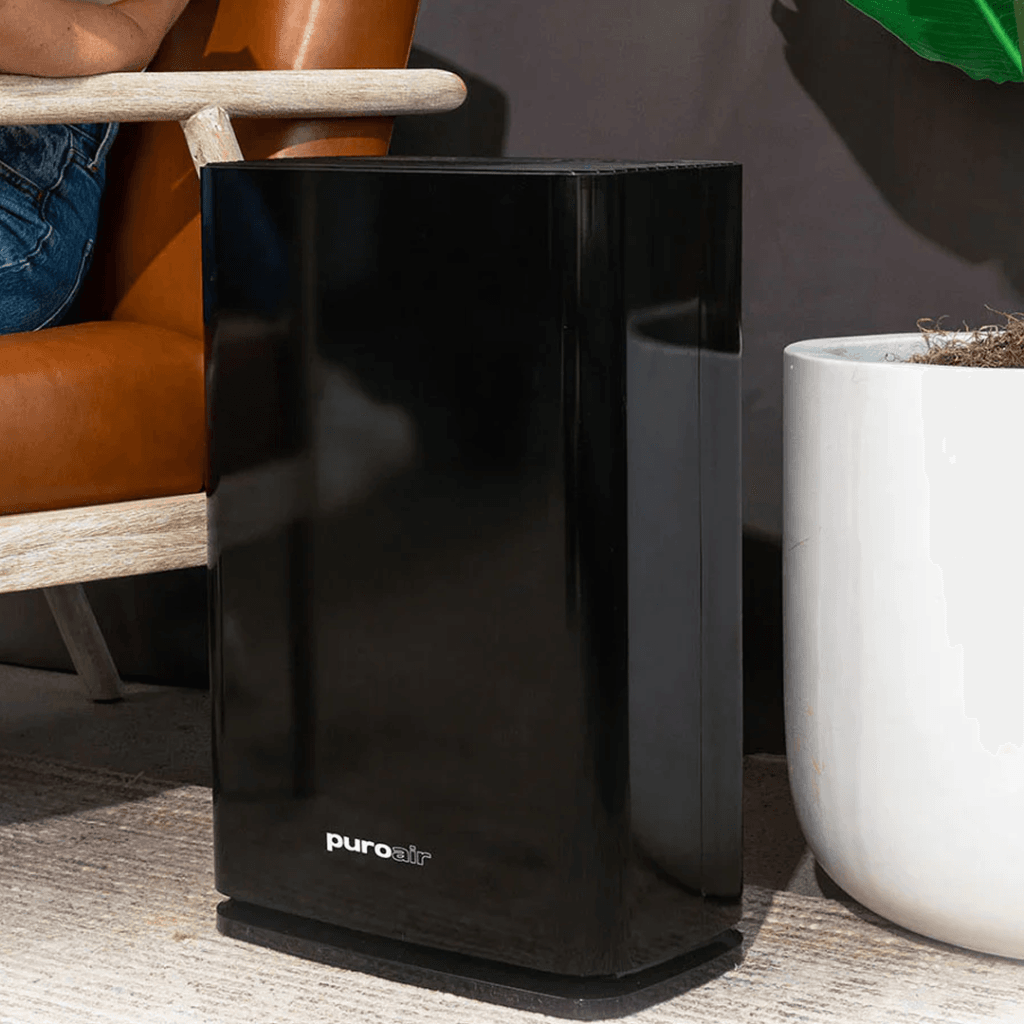
Ready to Experience Cleaner Air?
The Puroair 400 offers powerful air purification with its advanced HEPA 14 filtration system, perfect for large spaces up to 2,000 sq. ft.